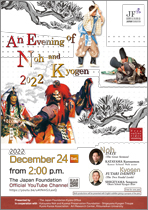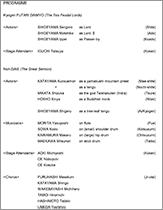An Evening of Noh and Kyogen 2022 (Free online video streaming)※Distribution closed on Monday, December 25, 2023 at 2:00 p.m..
Every year in autumn, The Japan Foundation Kyoto Office organizes an event called "An Evening of Noh and Kyogen" to give people an opportunity to experience traditional Japanese culture. This year, performances will be recorded once again to increase public visibility. Following that, these recordings will be available for free one year online video viewing.
| Date and time |
Saturday, December 24, 2022, from 2:00 p.m. *Free for one year |
|---|---|
| Program | <Kyogen> FUTARI DAIMYO (The Two Feudal Lords) Featuring: SHIGEYAMA Sengoro <Noh> DAIE (The Great Sermon) Featuring: KATAYAMA Kurouemon (Both productions will be presented with English subtitles giving a synopsis of the plot.) |
| Presented by | The Japan Foundation Kyoto Office |
| In cooperation with | Katayama Noh and Kyomai Preservation Foundation Shigeyama Kyogen Troupe Kyoto Kanze Association Art Research Center, Ritsumeikan University |
Programme Synopsis
Kyogen: FUTARI DAIMYO (The Two Feudal Lords)
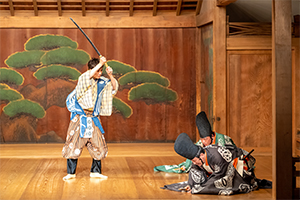
Synopsis
Two feudal lords are headed to the capital city of Kyoto. Unaccompanied by his servant, the protagonist feudal lord has to carry his tachi or long sword himself. They see a passerby and force him into service to carry the sword. Feeling indignant at the arrogance of the two feudal lords, the passerby swings the sword as if to slash the two, catching them off guard. The passerby turns the tables on the two. The two feudal lords have their clothes taken away and are made to act like roosters and dogs, laying themselves open to teasing.
In this "low overcoming the high" parable, the feudal lords, forgetting that they are being teased, gradually start to feel amused and end up having fun together with the man. The performance brings the laid-back atmosphere of medieval times to life.
<Kyogen>
Kyogen is a form of comic theater that emerged during Japan’s Muromachi period (around 1336 to 1573) and developed alongside Noh. It traces its origins to “Sarugaku,” a form of Japanese entertainment dating back to the late Heian period (mid-12th century). Later, the term “Nohgaku” was created to encompass these twin arts of Noh and Kyogen. While Noh is a tragic musical play, Kyogen is a comedy based on spoken dialog and wordplay. Performed as an interlude between acts of the more solemn Noh play, Kyogen creates comic relief, inducing laughter from the audience like a circus clown.
Stories of blunders in everyday life or making fun of the little quarrels among couples are the favorite motifs of Kyogen, a laughter theme unchanging even in modern days. Kyogen is a universal form of art that has made people laugh for centuries and will for centuries to come.
Noh: Daie (The Great Sermon)
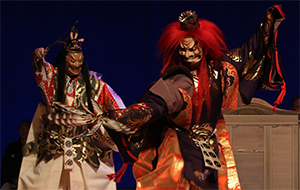
Synopsis
"Daie" means a great sermon in Buddhism. In this piece, it refers specifically to Sakyamuni's great sermon.
One day, a tengu in the guise of a yamabushi mountain priest appears before a Buddhist monk in training. The tengu says that the monk has once saved his life, so as a token of gratitude, he offers to grant the monk any wish he desires. The tengu had once been dropped from a tree when he was disguised as a bird. Just as he was about to be killed, the monk had come and saved him. The monk replies that he has always cherished the thought of seeing Sakyamuni deliver his sermon on the Vulture Peak. The tengu agrees to gratify his wish and show him the sermon, but warns the monk not to worship what he sees for it is not real, and then leaves.
The tengu's servant appears and recounts the story of how the tengu's life was saved.
The tengu reappears, in the guise of Sakyamuni and replicates the sermon. The monk, on seeing this, cannot help but worship the false image of the Buddha. No sooner has he done that than Indra, the guardian deity of Buddhism, descends from the heavens, rebuking the tengu for deluding the monk. Startled, the tengu sheds his disguise and reveals his true form. He apologizes, and then vanishes.
Tengus' existence destroys people's faith in Buddhism. Their evolution has taken some twists and turns, and in Japan, as we get closer to modern times, these creatures are often depicted as having long noses. However, tengu in Noh plays do not have this prominent feature.
Among the various types of Noh plays, there are Noh plays characterized by a faster tempo and which tell a fairytale-like story, like this piece, "Daie".
<Noh>
Noh traces its origins as far back as the 14th century, and it has continued to this day, uninterrupted. Noh was originally a form of entertainment for the common people, as a rite performed to pray for bountiful harvests and good fortune. It later began to draw its plots from works of classical literature, giving the audience a greater appreciation for the literary depth of the world. Its themes include gods’ blessings, prayers for the dead, manifestation of beauty, and states of emotional unrest in the face of a crisis. These themes are universal, and hence Noh has continued to be appreciated.
The methods of expression in Noh have been refined over hundreds of years, and are distilled down to a bare minimum, evoking the audience’s imagination and inviting them to actively infer the significance of each move for themselves. Masks, costumes, music, and movements embody the essential features of Japanese culture. Join us, and we will guide you through the world of Noh to invite you to experience the essence of Japanese culture.
Profile
SHIGEYAMA Sengoro
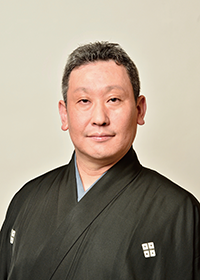
Born in 1972. Eldest son of Shigeyama Sensaku V. Birth name Masakuni.
First appeared on stage at the age of four as the protagonist of “Iroha.” Subsequently led such projects as the Hanagata Kyogen Kai, the Kyogen Shogekijo, “TOPPA!,” and the Kokoromi no Kai in his efforts to win new fans not just for Kyogen but also for Noh theater itself. Currently, he is working to communicate the appeal of Kyogen to a wider age-range of audiences by leading such projects as the Shigeyama Kyogen Kai, the “Cutting Edge KYOGEN” group (a revamped Hanagata Kyogen Kai), the Kashizuki no Kai in partnership with his younger brother, Shigeru, and the Waraenai Kai in partnership with Rakugo specialist Katsura Yonekichi. He has also actively collaborated with artists in other theatrical genres, including Yan Qinggu of the Shanghai Jingju Theatre Company and the Sichuan opera face changing master Jiang Peng. Succeeded to Shigeyama Sengoro XIV in 2016. Recipient of the Agency for Cultural Affairs’ New Artist Award of the National Arts Festival in 2005, recipient of Kyoto Prefectural Culture Award’s Distinguished Service Prize in 2008.
KATAYAMA Kurouemon
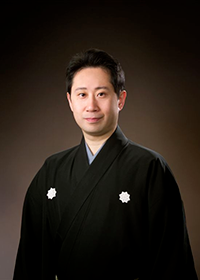
A shite (primary actor) of the Kanze School of Noh, Katayama Kurouemon was born in 1964 in Kyoto as the first son of Katayama Yusetsu (Katayama Kurouemon IX). His grandmother was the late Inoue Yachiyo IV, the former head of the Inoue School of the traditional Kyoto Kyomai dance, and his older sister is Inoue Yachiyo V, the head of the Inoue School.
He studied Noh under his father and then Kanze Tetsunojo VIII. He organizes the Katayama Regular Noh performances. He performs frequently in theaters throughout the country, and often joins overseas tours to Europe, the United States, and other countries as well.
He is involved in a variety of activities which are designed to share the joy of Noh with younger generations, including visiting Noh classes at schools, production of Noh picture books, and the creation of virtual Noh plays using computer graphics technology.
He is a recipient of the Kyoto Prefectural Cultural Encouragement Award, the Kyoto Municipal New Artist Award, the New Artist Award of the National Arts Festival of the Agency for Cultural Affairs, the Japan Traditional Cultures Foundation Award, the Kyoto Prefectural Culture Award’s Distinguished Service Prize, and the Minister of Education, Culture, Sports, Science and Technology’s Art Encouragement Prize for New Artists.
He is a holder of Important Intangible Cultural Properties (collective recognition) and also serves as director of the Kyoto Kanze Kai association and President of the Katayama Noh and Kyomai Preservation Foundation.
[Contact Us]
The Japan Foundation Kyoto Office
(3rd Floor, Kyoto International Community House 2-1 Torii-cho, Awataguchi, Sakyo-ku, Kyoto)
Tel: +81-(0)75-762-1136
- About Us Top
- About the Japan Foundation
- Donations
- News & Topics
- News & Topics Top
- Main Activities
- Main Activities Top
- Fiscal Year 2025-2026
- Fiscal Year 2024-2025
- Fiscal Year 2023-2024
- Fiscal Year 2022-2023
- Fiscal Year 2021-2022
- Fiscal Year 2020-2021
- Fiscal Year 2019-2020
- Fiscal Year 2018-2019
- Fiscal Year 2017-2018
- Fiscal Year 2016-2017
- Fiscal Year 2015-2016
- Fiscal Year 2014-2015
- Fiscal Year 2013-2014
- Events / Projects
- Press Release
- Press Release Top
- Fiscal Year 2025-2026
- Fiscal Year 2024-2025
- Fiscal Year 2023-2024
- Fiscal Year 2022-2023
- Fiscal Year 2021-2022
- Fiscal Year 2020-2021
- Fiscal Year 2019-2020
- Fiscal Year 2018-2019
- Fiscal Year 2017-2018
- Fiscal Year 2016-2017
- Fiscal Year 2015-2016
- Fiscal Year 2014-2015
- Fiscal Year 2013-2014
- Links

